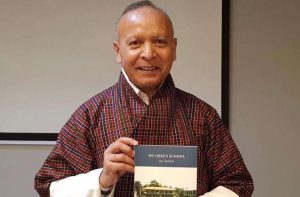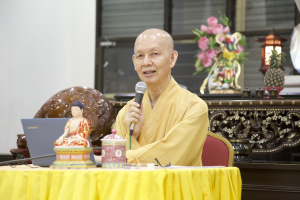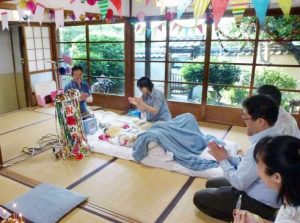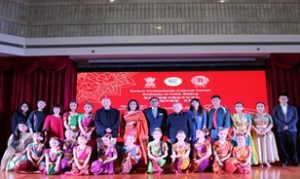
Beginner’s Mind is a special project from Buddhistdoor Global collecting insightful essays written by US college students who have attended experiential-learning-based courses related to Buddhism. Some of the authors identify as Buddhists, for others it is their first encounter with the Buddhadharma. All are sharing reflections and impressions on what they’ve learned, how it has impacted their lives, and how they might continue to engage with the teaching.
Coming into this Buddhist Material Culture course with limited exposure to religion or to religious studies, I was not sure what to expect. Throughout my educational experiences, I have always been drawn toward topics related to math and science because these have been areas in which I seemed to excel, but I now believe that these habits have placed me in a framework of thinking that is rather narrow. Perhaps I signed up for this course to broaden my intellectual horizons and incorporate new philosophies into my life? And while I feel that this course has enabled me to achieved these ends, I also believe that my experiences this semester have had a more substantial impact on my overall perceptions about the fundamental concept of life. Something that has captivated me throughout my explorations of biology, chemistry, and physiology is the question of what it means to be alive. Where is the boundary between the animate and the inanimate? Is life exclusive to the living? Unlike the investigations of any course I have previously taken, our explorations of Buddhist material culture have helped me find answers to these questions and have allowed me to reach a greater degree of clarity with respect to the illusive concept of life.
During the early stages of this course, I became fascinated with the notions of rebirth and non-self as we learned about some of the core Buddhist teachings. I began to realize that much of my conception of life has been shaped by Western scientific and religious thought. From my earliest years, I had been taught that life ends at the point of death, marking an absolute transition into either a spiritual realm (based on my Western religious knowledge) or nothingness (based on my Western scientific knowledge). But I never found either of these notions about the relationship between life and death satisfying or realistic. I believe that the Buddhist concepts of rebirth and non-self resonated with me because of a subconscious desire for clarity about the scope and boundaries of life.
What I found was that these concepts of rebirth and non-self point toward an understanding of life that is more continuous and comprehensive than the understandings that I have been taught for years. While working through the Peter Harvey and Damien Keown readings, I internalized the teachings about rebirth and non-self as they began to shape my views on life and the world as a whole. With regard to rebirth, I began to pay closer attention to nonhuman forms of life such as plants and animals while gaining a greater appreciation of how these organisms share the world and its environments with us. These organisms arose from the same conditions as humans, and nothing inherently suggests that their life is less valuable than human life; for all we know, these organisms could have even been human in their past lives. Additionally, the notion of non-self has heightened my awareness of how all non-sentient things are interwoven with human life, a social sphere that has normatively been separated from inanimate entities throughout Western culture. Life is not isolated from the multitude of material and nonhuman components that exist; life relies just as much on the air we breathe, the earth we stand upon, and the light we see, as it does on the ability to think or feel. I believe that these teachings have strengthened my sense of compassion and support for our natural and material environments as integral components of what life is.
In addition to our foundational readings, the discussions surrounding the theory of new materialism and its applications for Buddhist material culture have broadened my understanding of the forms that life can take. Sonia Hazard’s arguments about the agency of materials and the networks of influence that stem from interactions between human and nonhuman actors presented an unexpected yet intuitive understanding of how life realistically operates in our world. I see now that it is an oversimplification to suggest that life is exclusive to living organisms—life is evident in the structures that surround us, the technologies we use, and the items that we worship. Even if our material surroundings are not animate in the human sense, their presence has a living influence throughout our everyday lives, making them just as significant actors as other people in terms of how they shape our thoughts and behaviors. With these new insights, I have begun to recognize how my own material surroundings, from my running shoes to my laptop, alter the decisions and types of interactions that I make. Going forward, I believe that I will be more cognizant of the fact that life is not exclusive to the creatures that eat and breathe; there is a universe full of material life that influences and experiences the consequences of our actions, and this material world should not be overlooked.
There were so many valuable lessons that I gained throughout this course, but if I had to synthesize these lessons into a major takeaway, for me it would be that I have gained a renewed sense of what life is. I think that my main revelation from taking this course is that life is perpetual and shared among every entity throughout the universe. I remember being so scared when I was younger by the thought of me or my loved ones dying, but I believe that this course has allowed me to realize that death is neither as discrete nor as absolute as I might have thought. So many things “live” and act without having human intelligence, flowing blood, or even physical presence at all, such that our physical lives as humans now appear to me as a small and fleeting component of what life truly is. Life does not stop when our hearts stop beating; we live on in the world that we produce and in the world that produced us.
Cody Carrier wrote this essay for his Buddhist Material Culture course at Williams College. He will graduate in 2021 with a major in Chemistry. Spending his teenage years in Florida, Cody developed a passion for outdoor activities such as running, surfing, and playing soccer. Cody enjoys projects that let him engage with his community, and he hopes to pursue a career in medicine following his graduation from Williams College.
References
Harvey, Peter. 2000. An Introduction to Buddhist Ethics. Cambridge: Cambridge University Press.
Hazard, Sonia. 2013. “The Material Turn in the Study of Religion” in Religion and Society: Advances in Research 4: 58–78.
Keown, Damien. 2005. Buddhist Ethics: A Very Short Introduction. Oxford: Oxford University Press.











